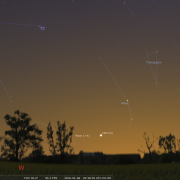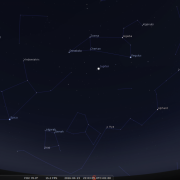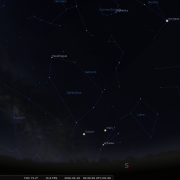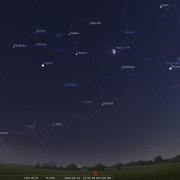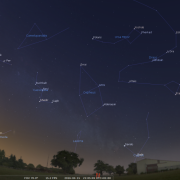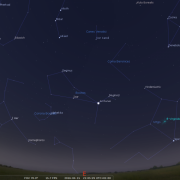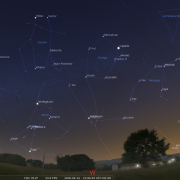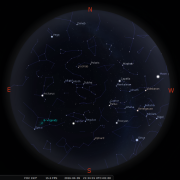Welcome to the WDAS monthly newsletter for April 2016: a digest of the month's latest contributions to our website. Below you'll find Society News, Sky Notes and In-Focus articles printed in full. There's also future events, and trailers for other articles which appear in full on the website - just a click away!
On the website you'll also be able to comment on articles, and if you'd like to play an editorial role in creating new content, just let us know!
Quick Summary for April:
- WDAS Society Meeting on Tuesday 12th April from 19:30h. A week later than our usual meeting, because of the schools' Easter holiday. Mark will be talking about Mars, and Andi will tell us how the Universe could have been created from nothing.
Society News
 Organised by Claire Barber, Head Teacher at Fylingdales Primary School, Fylingthorpe, to tie in with the pupils work projects on space and the night sky.
Organised by Claire Barber, Head Teacher at Fylingdales Primary School, Fylingthorpe, to tie in with the pupils work projects on space and the night sky.
It was such a shame for all concerned that the weather conspired against us for the duration of the visit. The prefab room was full to overflowing - standing room only for the indoor presentation. Outside, the forecast intermittent light rain, fell as persistent, heavy rain! No observing then, but there was still plenty of enthusiasm to perform the scale solar system demo.
Keen as mustard they were to see what Jupiter, Saturn and the outer gas worlds looked like in the rain. This solar system was particularly rich in H2O, if not a little squelchy underfoot.
Still, once back inside the potential of turning the prefab into a steam sauna, could clearly by gauged, especially if you wore glasses! After another quick presentation and a really impressive question and answer session, it was time to set sail ...err, depart, just as the rain eased and clouds began to break.
Plans are already in the pipeline for further visits, hopefully when we can at least point objects out.
 Following our adventures down at the hostel in February, a sequel has been planned for April 5th (20:30pm start), assuming that is skies are not totally overcast or it’s raining, in which case the event is likely to be postponed. If it is partly cloudy, so that observations are possible, the format will be similar to last time.
Following our adventures down at the hostel in February, a sequel has been planned for April 5th (20:30pm start), assuming that is skies are not totally overcast or it’s raining, in which case the event is likely to be postponed. If it is partly cloudy, so that observations are possible, the format will be similar to last time.
The hostel does now have its own scope, so at least two scopes could be employed, possibly more if members are prepared to carry a smaller instrument down. We probably won’t know until a few days out whether this will go ahead, so Mark will ring all those likely to be able to lend a hand.
Observatory sessions have been more successful in the March. On Sunday 13th March there was an astro-photography session. The pictures below were both taken by Mark. On the left, a picture of Keith with his camera attached to the Cooke Refractor, photographing the moon (which you can see on the picture if you look carefully), and on the right a photo of the moon through Mark's compact camera, held up to the Cooke Refractor. For a couple more photos, see the Gallery.
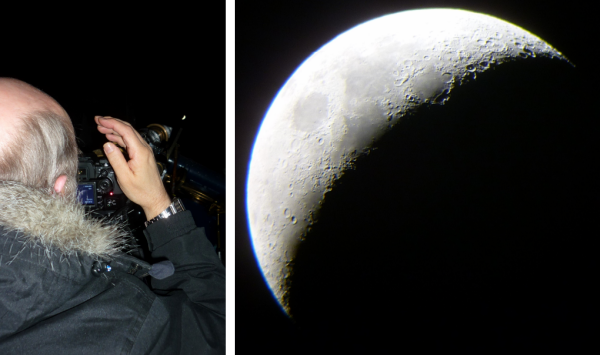
On the following weekend, Andi's niece was treated to a sky tour by Mark and was overwhelmed by images of Jupiter and its moons through increasingly powerful lenses.
Sky Notes
In this month's Sky Notes:
Planetary Skylights

 Although Jupiter is currently the brightest planet in the sky, April is all about Mercury, which has its best apparition of the year. Closest to the Sun, Mercury never strays far from the general direction of our nearest star, and hence is only seen in a twilight sky, before sunrise or shortly after sunset. Even for a good apparition Mercury barely reaches 10-12 degrees above the horizon, before arcing back down, a period lasting no more than 4 weeks. Not surprisingly Mercury is the most elusive of the visible naked eye planets to spot.
Although Jupiter is currently the brightest planet in the sky, April is all about Mercury, which has its best apparition of the year. Closest to the Sun, Mercury never strays far from the general direction of our nearest star, and hence is only seen in a twilight sky, before sunrise or shortly after sunset. Even for a good apparition Mercury barely reaches 10-12 degrees above the horizon, before arcing back down, a period lasting no more than 4 weeks. Not surprisingly Mercury is the most elusive of the visible naked eye planets to spot.
In order to see Mercury this coming month you will require a clear West-to-WNW horizon. Wait until 40 minutes after sunset before scanning above the horizon. Use binoculars initially, Mercury will be the brightest ‘star’ in this direction. Once located, you should then be able to spot it with just the naked eye, appearing surprisingly bright in the twilight sky. Mercury reaches greatest eastern elongation on the 18th when it will be 10 degrees above the horizon, however it will be brightest earlier in the month, so the optimum dates to view will be from 8th-12th. A very slim crescent moon lies to the left of Mercury on the 8th.
Conspicuous Jupiter dominates the evening sky residing below the stars of Leo over in the south as twilight deepens. As it is the brightest object it cannot be mistaken. For the majority of observers Jupiter is now at its most convenient to scrutinize through a telescope. It is always a rewarding spectacle. Note the current state of the banding across its disk, and the size and hue of the great red spot – when visible. The nightly dance of the attendant Galilean moons, is also always of great fascination. Jupiter resides above our moon on the 17th.

 Mars and Saturn are still morning objects, although they are now rising earlier post midnight. Mars has an obvious ‘orange’ hue and is gradually brightening as it heads toward a May opposition date. Telescopically, the disk still appears disappointingly small (nowhere near the size of Jupiter’s, even when Mars is at its very best) but a 6 inch scope or larger may reveal some general surface markings. Saturn resides to the left of Mars and appears pearly white to the naked eye. Turn a scope toward Saturn and you will be greeted by one of nature’s most beautiful sights – the glorious ring system. The moon passes Mars and Saturn on the 25th-26th.
Mars and Saturn are still morning objects, although they are now rising earlier post midnight. Mars has an obvious ‘orange’ hue and is gradually brightening as it heads toward a May opposition date. Telescopically, the disk still appears disappointingly small (nowhere near the size of Jupiter’s, even when Mars is at its very best) but a 6 inch scope or larger may reveal some general surface markings. Saturn resides to the left of Mars and appears pearly white to the naked eye. Turn a scope toward Saturn and you will be greeted by one of nature’s most beautiful sights – the glorious ring system. The moon passes Mars and Saturn on the 25th-26th.
For a more in-depth look at April’s planetary movements, please refer to your 2016 Night Scenes, assuming you have a copy.
Meteor Showers

A number of lesser meteor showers occur during April. The Virginids and Alpha Scorpiids each have zenith hourly rates (ZHR) of around half a dozen, equating to ‘normal’ sporadic meteor activity levels. The Virginids peak on April 7/8th, which is a ‘no moon’ window, therefore increased sightings of Virginids during the early morning hours is quite likely. The Scorpiids peak on the 27th and will be hampered a little by a waning moon in the early morning hours.
The month's most prolific shower, the Lyrids, peak over the 22/23rd. Normally having a ZHR of around 20 per hour, a full moon on the 21st will severely restrict observations this year.
March 2016 Sky Charts
Click each image to see a full-size Sky Chart:
|
Looking South
Mid April - 21:00h |
Looking North |
|
Looking East
Mid April - 21:00h |
Looking West
Mid April - 21:00h |
|
|
|
|
Overview
9th April - 21:35h |
|
Additional Image Credits:
- Planets and Comets where not otherwise mentioned: NASA
- Sky Charts: Stellarium Software
In-Focus
Compared to the departing stellar canopy of winter, at first glance the spring sky may seem rather less inspiring. Yet, appearances can be deceptive and there is much to wonder at amongst the constellations now arranged across the south and east.
Our tour commences as darkness falls around 21:45h. By then Leo, the most readily identifiable spring constellation is located due south. The head and mane of the lion is marked by the distinctive star asterism known as the ‘sickle’, although some people view it as a backwards question mark. At the base of this arrangement shines prominent Regulus, Leo’s chief star, and faintest of the 1st magnitude stars. Regulus sits just above the ecliptic and as a consequence is sometimes occulted by the Moon and on very rare occasions by a planet.
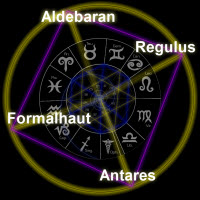
"Royal Stars of Persia"
Aldebaran (Taurus): Vernal equinox
Regulus (Leo): Summer solstice
Antares (Scorpio): Autumnal equinox
Fomalhaut (Aquarius): Winter solstice
In antiquity; from 4000 to 2000 BC Regulus was counted as one of the four Royal stars, those bright stars closest to the equinox and solstice positions. During this period Regulus was nearest the summer solstice position, but the effect of precession has subsequently shifted this point well away.
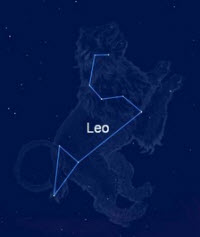
Constellation: Leo
To the left of the sickle, a ‘triangle’ of stars depicts the hindquarters of Leo. Just beneath an imaginary line joining Regulus to Denebola, the rearmost star of this triangle, a number of galaxies are found, some of which are visible under good seeing conditions in smaller scopes (see chart).
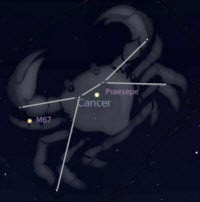
Constellation: Cancer
Ahead of Leo scuttles Cancer, faintest of the zodiac constellations the stars of which are often drowned out by moonlight or light pollution. Cancer is home to the fine open cluster M44 or Beehive, sometimes known as the Praesepe; ‘the ‘manger’. To the naked eye it appears as a misty patch, but a small scope reveals many individual stars.
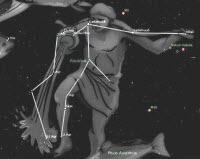
Constellation: Hydra
Our next destination, Hydra – Water Serpent, is the largest constellation in the heavens, extending from below Cancer in the WSW, to beneath Virgo down in the ESE. Indeed it is well after 11pm before the entire constellation is visible. Hydra’s brightest star; Alphard- the ‘solitary one’, is located a hands span to the southeast of the distinctive, though rather faint, loop of stars marking the beasts writhing heads, visible to the right of Regulus.
In Greek mythology Leo, Cancer and Hydra are all associated with Hera, Queen of the gods. Both Leo and Hydra were raised as pets by Hera. Leo’s coat was said to be impervious to fire and metal weapons, whilst the multi-headed snake was empowered with the ability to re-grow heads should one be cut off. In the first of his twelve labours, Hercules, whom Hera despised, was tasked with slaying the lion beast ravaging the region of Nemea. He duly trapped the beast in a cave and clubbed it to death. In honour of this deed, Zeus placed the lion in the heavens.
Decidedly miffed by the loss of her pet, Hera then pitted Hercules against the multi headed Hydra, which he overcame by using flaming arrows to cauterise the neck-stumps thus stopping the heads from regenerating. Hera; who saw the snake was in trouble, sent a giant crab (Cancer) to assist Hydra. In the ensuing battle Hercules also crushed the giant crustacean. A distraught Hera then placed both monstrous creatures in the heavens.
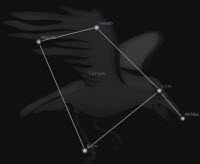
Constellation: Corvus
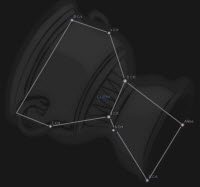
Constellation: Crater
Toward the tail of Hydra, two small but original constellations rest on snakes body; Corvus the Crow and Crater the Cup. The outline of Crater is rather faint and therefore difficult to trace in light polluted skies. Corvus is more prominent; a quadrilateral grouping of stars that, mariners and astronomers alike refer to as ‘Spica’s Spanker’, a spanker being a type of sail nearby the bright star Spica.
Corvus and Crater are linked by one legend in which Apollo sent his pet white crow to fetch a cup of water. The bird flew off with the cup in his talons, but tarried, waiting for the fruit of a fig tree to ripen. On his return Corvus tried to convince Apollo that Hydra the water snake had delayed him. Apollo did not believe the bird and in a rage turned the crow black, dispatching him to the sky close to Crater, which is just out of the thirsty bird’s reach.
With the introduction of BST it is after 21:00h before skies grow fully dark, by which time many of the seasonal constellations associated with winter are on the verge of departing. Spring groups now occupy much of the sky to the south and east. Of the star groups arranged in the south, three are associated with the labours of Hercules; Cancer, Hydra and Leo (covered in detail, see The Lion and the Serpent.)

Artist's impression of Spica:
hot, massive, double-star system
distorted as they whirl around
each other every 4 days
Following the celestial Lion across the sky, Virgo, is ranked second to Hydra in size and contains the first magnitude star, Spica (mag 0.97). Spica looks like one star, but it is at least two stars, both larger and hotter than our sun, orbiting only 18 million kilometers (11 million miles) apart. Their mutual gravity distorts each star into an egg shape, with the pointed ends facing each other as they whirl around, completing a single orbit in only four days. The stars reside around 262 light years away and are at least 300 times more luminous than our Sun. The surface temperatures are estimated at 22,400 K and 18,500 K for the larger and smaller components, respectively.
The outline of Virgo has been likened to that of a large distorted letter ‘y’ with Spica situated at the bottom of the ‘leg’. According to one legend Virgo represents Demeter; mother goddess of Earth, whose daughter, Persephone, after being pierced in the heart by one of Eros’s love arrows, was forced to return to the underworld ruled by Hades, who instantly fell in love with her. Hearing the cries of her daughter, Demeter searched the world over without success, cursing the ground so that no crops would grow. Eventually Demeter learned of the whereabouts of Persephone and begged Zeus to free her. However Persephone was only allowed to return to Earth’s surface for six months in the year – spring and summer, descending back down into the underworld for autumn and winter, a reflection of when Virgo is visible in the sky.
The area of sky within the ‘bowl of Virgo’ and extending up toward Coma Berenices is known as the realm of the galaxies, a window onto the wider universe. Through this window we are looking toward several galaxy clusters belonging to our local super cluster. The Virgo cluster lies some 40-60 million light years distant, with the more remote Coma galaxy cluster approximately 300 light year distant.
Although Berenices consists of just a smattering of stars, it is one of the original 48 constellations, said to represent the amber tresses of Queen Berenices II. She was sister too and wife of King Ptolemy III of ancient Egypt. Berenices vowed to cut off her beautiful hair and place the tresses in the temple of Venus on the safe return of her husband from war with the Assyrians. The King was victorious and the Queen duly kept her promise, but the tresses disappeared from the temple, according to the court astronomer, Conon, removed by Zeus himself, honouring the donor by placing them in the sky.
To the naked eye Coma may be rather inconspicuous, however it is rewarding to explore with many pleasing cascades of fainter stars visible in a telescope or pair of binoculars. A modest instrument (4 inch diameter) will yield several of the brighter galaxies and 15 are listed in the Messier catalogue. All of the galaxies appear as elliptical or elongated smudges. Larger amateur scopes reveal at least a couple of dozen galaxies, one reason why amateur astronomers stretch their patience to the limit when peering through this window.
Our final destination, Bootes, pronounced Bo-eh-tes, is currently visible in the ESE. The outline of the constellation resembles that of long kite, dented somewhat on one side. Its chief star, brilliant Arcturus, resides at the foot of this pattern. The name Arcturus comes from the Greek meaning “guardian of the bear” due to its relative proximity to the Great Bear. According to legend Bootes was the son of Demeter and was rewarded with a place in the heavens for having invented the Ox driven plough.
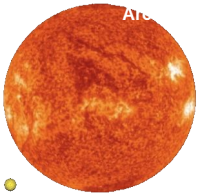 Arcturus itself is the second brightest star visible from Britain and has a lovely deep amber hue. At a distance of just 37 light years, Arcturus is the nearest example of an orange giant star, cooler, older and larger, around 30 times greater in diameter and 113 times more luminous. Arcturus is an example of a star post Helium flash, one that now fuses Helium in its core. It may continue to do this for another 100-150 million yrs before expanding yet again eventually becoming a planetary nebula and white dwarf. In the distant future our Sun will evolve into a star resembling Arcturus. From the UK, Arcturus (mag -0.04) is the second brightest star visible after Sirius, but remains in our skies for much longer – approx 9 months
Arcturus itself is the second brightest star visible from Britain and has a lovely deep amber hue. At a distance of just 37 light years, Arcturus is the nearest example of an orange giant star, cooler, older and larger, around 30 times greater in diameter and 113 times more luminous. Arcturus is an example of a star post Helium flash, one that now fuses Helium in its core. It may continue to do this for another 100-150 million yrs before expanding yet again eventually becoming a planetary nebula and white dwarf. In the distant future our Sun will evolve into a star resembling Arcturus. From the UK, Arcturus (mag -0.04) is the second brightest star visible after Sirius, but remains in our skies for much longer – approx 9 months
Organizers for the Chicago World's Fair in 1933 were searching for a memorable way to open their exhibit, and hit upon the idea of using its star light. At 21:15h Central Time on May 27, 1933, telescopes focused the star's light on several photoelectric cells. The current was used to flip a switch that turned on the floodlights at the expedition grounds.
Of the brighter stars visible in the sky, Arcturus has by far the greatest ‘proper’ or true movement as seen against the background sky, indeed Arcturus appears to move a distance equivalent to the Moons diameter every 1000 years. This is because it is plunging through the galactic plane, cutting across the path of the Suns trajectory as it orbits around the Milky Way.
Initially Arcturus will appear even brighter in our skies, but thereafter will rapidly diminish in brilliance, and in a few thousand years will become just another anonymous face in the stellar crowd!
Events
 Observe the night sky with us at the Bruce Observatory, Whitby School
Observe the night sky with us at the Bruce Observatory, Whitby School
Observing Nights are held weather permitting: check for a relatively clear sky before leaving home. If in doubt, Mark can be reached on 07886069339
Please note the college drive gate is now operated via a electronic key code - so anyone wishing to attend must be at the car park at the top of the drive by 19:00hrs - unless an arrival time has been arranged with Mark/Keith.
 Whitby School - Room H1.
Whitby School - Room H1.
In Members' monthly meetings we usually take a tour of the night sky for the coming month using the Planetarium program. Have talks and presentations on various topics of astronomy/space etc, and discuss future events etc. New members welcome.

